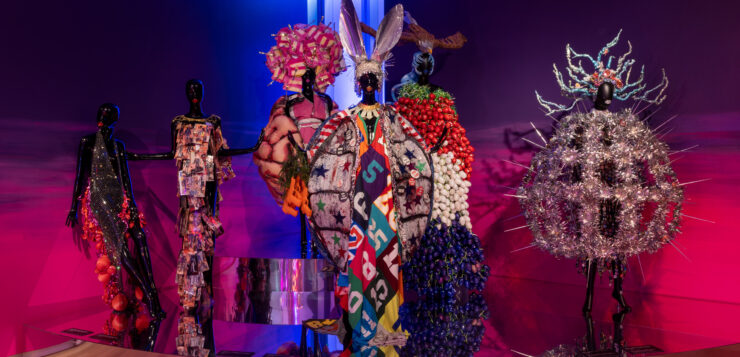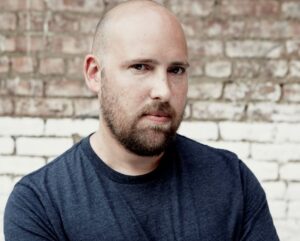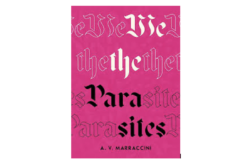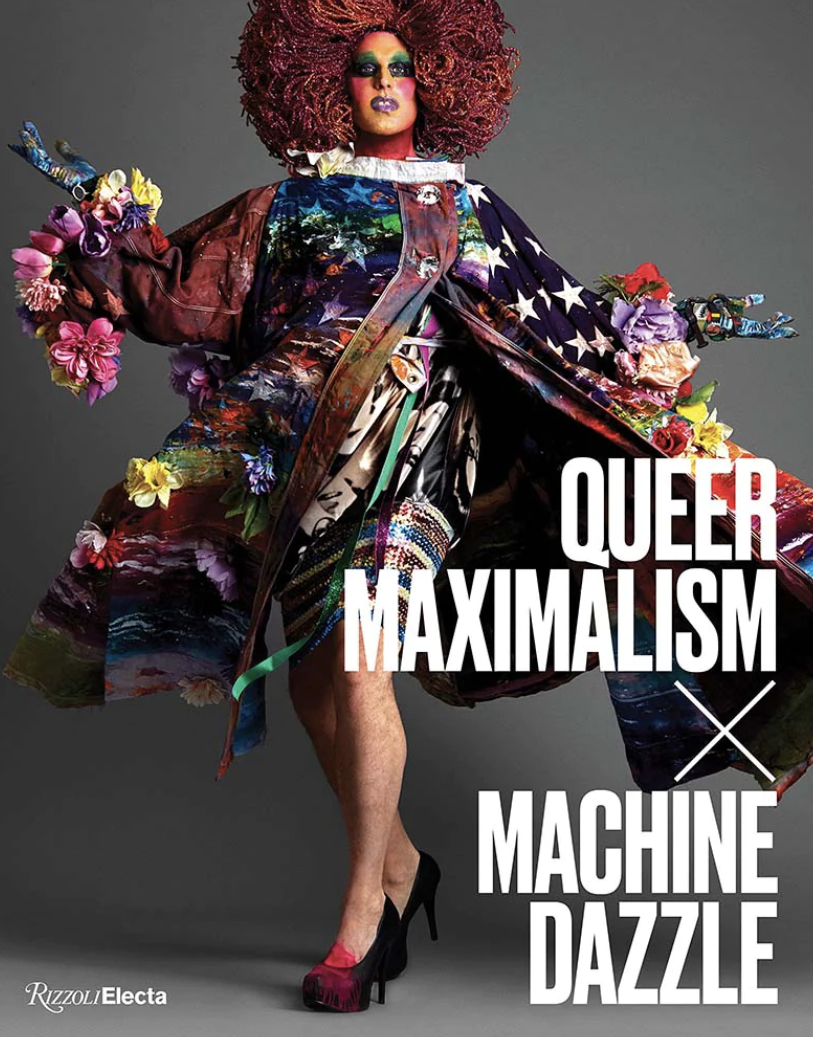 Queer Maximalism x Machine Dazzle
Queer Maximalism x Machine Dazzle
Museum of Arts and Design, New York City
Sep 10, 2022–Feb 19, 2023
The first solo exhibition of Machine Dazzle, the nom d’artiste of Matthew Flower, recently concluded at the Museum of Arts and Design in New York City. Spread out over two full gallery floors like synthetic blossoms, the exhibit was comprised of over eighty creations built for performance; the costumes displays queered the notion of what theatrical design can be, blending found materials and foundational concepts with a spirit of radical reinvention. Familiar detritus like bottlecaps, plastic toy soldiers, and wine corks are refashioned, repurposed, and rearticulated. While an attention to theme and an intellectual foundation undergirds each design, there is a deliriously-chaotic accretion to the pieces. Self-taught, Dazzle uses his sewing machine where other artists might a paint brush or chisel, sculpting and layering, conveying a sense of the improvisatory rather than following a pattern.
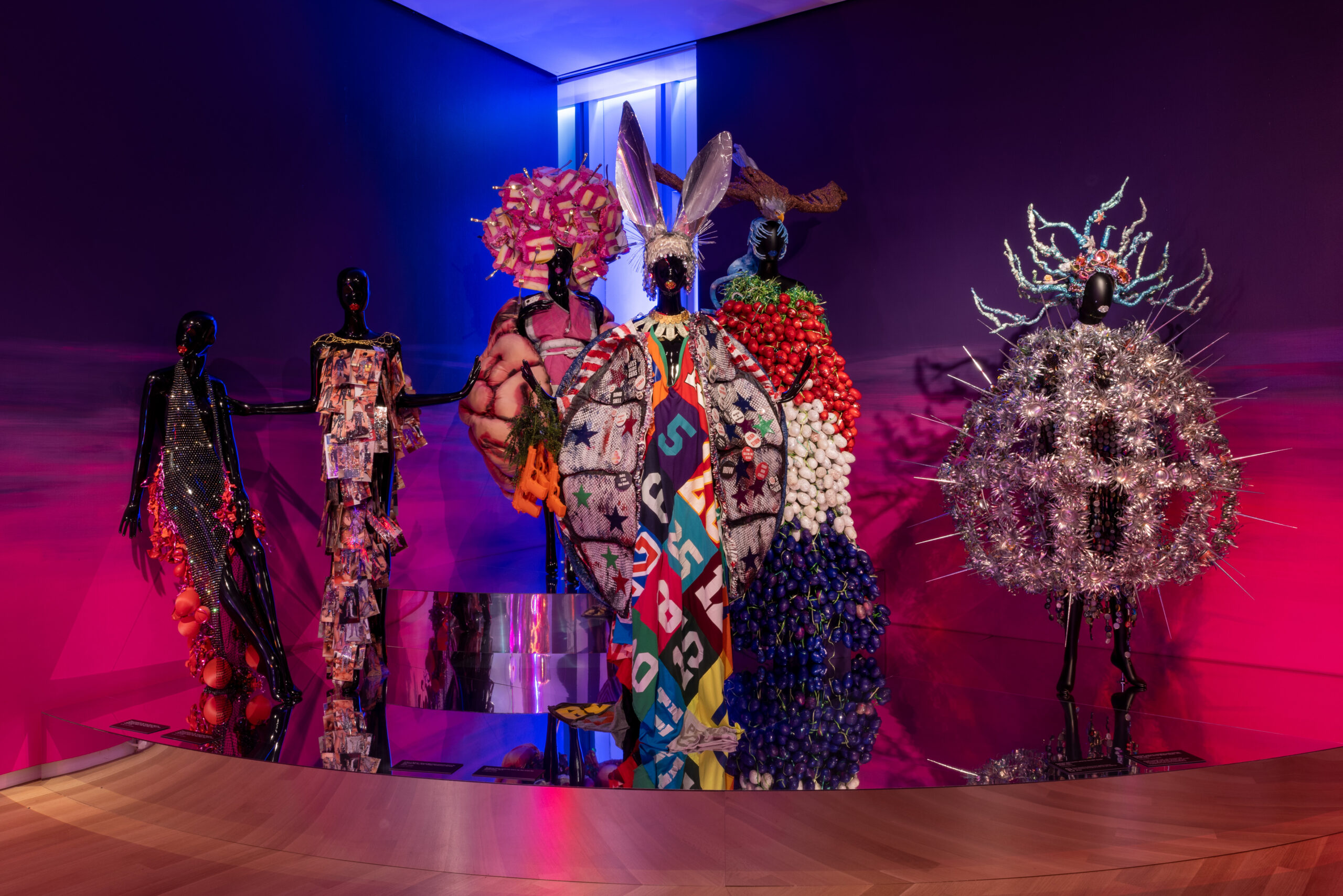
In a way, the designs in Queer Maximalism function like the visual equivalent of Polari—the underground argot formerly spoken by buskers, beggars, circus artists, and later, by the homosexuals of London’s gay clubs, primarily an aesthetic slang borne out of the incubator of the downtown performance scene where Dazzle developed and honed his signature approach. The collaborative commingling of his artistic DNA starting in the mid-1990s with the glitter-crusted, Solid Gold-on-acid troupe, the Dazzle Dancers—from whom his name derives—whose ethos were “Having fun is a political act,” according to co-founder Mike Albo (aka Dazzle Dazzle).The cross-pollination of nightlife and performance spilled across clubs, lounges, back rooms of bars like the Slide or the Cock, and performance spaces, in collaborations with compelling queers and luminaries like Julie Atlas Muz, Big Art Group, puppeteer Basil Twist, and cabaret icon Justin Vivian Bond. That scene, stretching through the early-to-mid-2000s, was in many ways a reaction to Giuliani’s crackdown on nightlife, as well as post-9/11 jingoism and security state posturing, resulting in resurgence of seriously filthy fun.
Perhaps the fullest expression of Dazzle’s work comes in his partnership with MacArthur Genius grantee Taylor Mac, with the entire fifth floor of the museum devoted to the stage costumes he made for A 24-Decade History of Popular Music, Mac’s queered retelling of US history through the American songbook, which was a finalist for the Pulitzer Prize in Drama. For those performances, Dazzle designed what he termed companion costumes, allowing him to appear onstage as Mac’s dresser and perform costume changes in front of the audience, a form of participation that queers the traditional relationship between costumer and performer, backstage and onstage roles. As with previous pieces, these designs incorporate nods to kitsch and Americana, revealing the tension between whimsy and gravity that permeates Dazzle’s work, while offering some of the most intricate constructions.

Several designs ask the viewer to examine them more closely. There is the macramé dress, a cross between a plant hanger and Japanese Shibari knots from the Stonewall Riot/Summer of Love section of Mac’s show. The lampoon of a hoop dress for the Civil War section of the show, an imposing cage woven of imitation barbed wire and hot dogs. Why? As Dazzle told the New York Times, because barbed wire was invented circa the 1860s, “and I read in a couple places that the American hot dog was invented in this time by German immigrants.” For the decade that covers WWII, Dazzle’s design incorporates nods to both the atomic bomb and the Slinky, each inventions of the time, mining the strains of the kitsch and terror of that era. Prominently displayed in the exhibition is the outfit Mac wore for the decade of the 1960s, an allusion to Jackie Kennedy’s iconic pink Chanel suit and pillbox hat. Rendered in Ben-Day dots in the style of pop artist Roy Lichtenstein, with a shawl of Campbell’s soup cans on shoulders, Dazzle’s look evokes the optimism and tragedy of the era.
Dazzle’s visual gestures aren’t exclusively queer, but they do transmit additional information to the receptive and attuned. As Polari made a game out of words, borrowing and twisting the grammars of the margins—Italian lingua franca, Romani, cockney rhyming slang, Yiddish, and circus-speak—in linguistic promiscuity, Dazzle’s designs too weave in elements that signal to fellow travelers. They nod to the illicit, outlandish and outlawed, and are recycled into something oddly beautiful—disposable plastic drugstore Halloween vampire teeth, a garland of Pez dispensers, a headpiece of 3-D glasses. A Bricolage borrowed from drag and burlesque, drawing a line to performers of previous eras, like the acid drag of the Cockettes and the giddy debauchery of Leigh Bowery.
As additional photos and the accompanying show catalog by Rizzoli show, Dazzle’s theatrical ensembles aren’t bound by the footlights or proscenium arch; they are equally as arresting and statement-making at public spectacles throughout New York, from parades (Coney Island Mermaid, Halloween, Easter) to queer liberation marches, and events like Night of 1000 Stevies.
Dazzle says his costumes are like living sculptures; they morph and evolve through use and wear. Though it’s hard to capture the alchemy that marries performer and costume in a museum setting, even through video clips and elaborately-articulated mannequins, Dazzle attempts to give a sense of that unique fusion.
Ultimately, the show’s expansiveness allows viewers to marvel at the marvelous paradoxes of Dazzle’s signature style: playful yet rigorous, arch but accessible, intricate and unsubtle; and more in the mode of DIY glamour pitched to the receptive viewer, effusive, dizzying, and in the parlance, fantabulosa.
Mike Dressel is a writer and educator based in New York.


